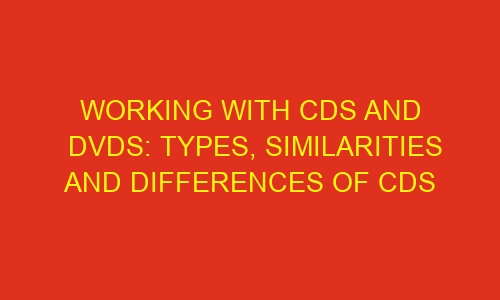Laser information storage devices are an integral part of modern life. Working with CDs and DVDs is relatively easy, so the drives are in high demand.
Such drives are the basis of most multimedia and gaming devices. Laptops, PCs, and even car interiors are equipped with them. Blank CDs offer a versatile solution for storing and sharing digital content with high-quality recording capabilities. However, only some people know the differences between CDs and what to consider when buying them.
Optical Disks: Everything About Them
Before considering the similarities between CDs and DVDs, it is necessary to understand the definition of an optical disk. The laser element includes four layers:
- Polycarbonate-based plate – we are talking about colorless plastic; it is thin and on top of the product. It is inscribed on it; you can print pictures on the surface.
- The working layer is a special dye. This part is burned with the use of a laser.
- The thin metal layer is created with the use of non-ferrous metals. Depending on the category of the disc, this part is made of precious metals, aluminum, and various alloys. Metal reflects laser beams well.
- The varnish on top of the metal – the bottom or base, protects the infolayer from damage and loss.
Now you know what CDs are made of. Let’s break down the process of recording information: a laser beam moves along a spiral-shaped track from the center of the disc to its edges and burns through the working points. The laser beams do not reflect the burned parts of the track, while the untouched parts are reflected due to the metal layer.
This produces a binary code – if the beam is reflected, the result is 1; if not, it is 0. This code is the basis for recording digital data.
What are CDs and DVDs
The size of DVD disks is by no means their most important characteristic. Thickness is about 1.2 mm; volume is different. CD R is a plastic compact disk with a one-sided (most often) information recording; in DVD media, the recording is on both sides. The part with information is always long, spiral-shaped, has a groove, and starts in the center of the disc media.
A CD disk is used for writing and reading data. This process is carried out using a laser of low power. Information streams can have different shapes. The laser beam first passes through the stages of reflection and then gets to the receiver.
The peculiarity of data storage on CD disks is that the information is read from the bottom of the carrier – for the laser beam, there is a ledge, whereas it is reflected from it, the course of the wave of the beam comes out less – about half of the wavelength itself. Motion is suppressed, and a no-signal alert appears.
What is the difference between a CD and a DVD with a roughly similar device? In the second case, the pitch of the groove is smaller, and the size of the protrusions will also be insignificant. The diameter of a CD disk can be much larger to record a similar amount of data than for DVD media. If maximum capacity and compactness are essential, you need the second option.
CD and DVD Similarities
There are many similarities between CDs and DVDs, but many more differences. CD capacity will depend on the model rather than the type of media – many different options are available. If the capacity of the CD RW disk is large, it will be possible to rewrite large amounts of data.
By the way, a CD disk is a designation of the type of media; it can be rewritable and non-rewritable. However, the original memory object determines the maximum allowable amount of information for primary recording. The maximum information capacity of a CD disk is always indicated on the box or envelope.
Both types of media are used in modern computers.

